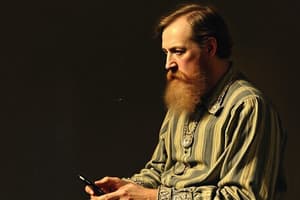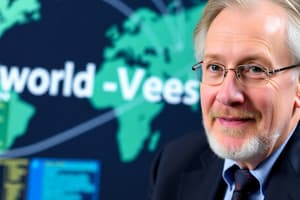Podcast
Questions and Answers
Which of the following factors most directly inspired Tim Berners-Lee to develop the World Wide Web?
Which of the following factors most directly inspired Tim Berners-Lee to develop the World Wide Web?
- His early interest in creating multimedia libraries for public use.
- The growing political and commercial interests threatening the internet.
- The communication challenges posed by the multilingual staff at CERN. (correct)
- His desire to create a social space accessible via the internet.
What was the key innovation proposed in Tim Berners-Lee's 1989 paper, 'Information Management: A Proposal'?
What was the key innovation proposed in Tim Berners-Lee's 1989 paper, 'Information Management: A Proposal'?
- A new method for encoding multimedia content for digital storage.
- A detailed plan for CERN's transition to digital communication.
- An outline for a linked hypertext data system. (correct)
- The concept of a universally accessible social networking platform.
How did ENQUIRE, the early program written by Tim Berners-Lee, contribute to the later development of the World Wide Web?
How did ENQUIRE, the early program written by Tim Berners-Lee, contribute to the later development of the World Wide Web?
- It established the fundamental protocols for secure online transactions.
- It was the first program to successfully connect computers across different continents.
- It introduced the use of HTML, HTTP, and the first browser.
- It demonstrated the potential for storing information and tracking connections between people and projects. (correct)
What distinguishes Tim Berners-Lee’s contribution to the internet from the contributions of those who developed the physical network of computers?
What distinguishes Tim Berners-Lee’s contribution to the internet from the contributions of those who developed the physical network of computers?
Which of the following best describes Tim Berners-Lee's vision for the World Wide Web?
Which of the following best describes Tim Berners-Lee's vision for the World Wide Web?
What was the significance of Tim Berners-Lee's parents' profession in relation to his later achievements?
What was the significance of Tim Berners-Lee's parents' profession in relation to his later achievements?
What potential challenge to Tim Berners-Lee's original vision for the World Wide Web is mentioned?
What potential challenge to Tim Berners-Lee's original vision for the World Wide Web is mentioned?
In what year did Tim Berners-Lee launch the World Wide Web at CERN, along with the key technologies that enabled its use?
In what year did Tim Berners-Lee launch the World Wide Web at CERN, along with the key technologies that enabled its use?
Besides HTML and HTTP; according to the text, the text says what other technology was launched with the World Wide Web?
Besides HTML and HTTP; according to the text, the text says what other technology was launched with the World Wide Web?
What unique contribution did Tim Berners-Lee make by 'setting the World Wide Web free' in 1991?
What unique contribution did Tim Berners-Lee make by 'setting the World Wide Web free' in 1991?
Flashcards
Who is Tim Berners-Lee?
Who is Tim Berners-Lee?
A British computer scientist who invented the World Wide Web.
What is ENQUIRE?
What is ENQUIRE?
A program written by Tim Berners-Lee in 1980 to connect CERN academics and their projects.
What is "Information Management: A Proposal"?
What is "Information Management: A Proposal"?
Submitted in 1989, it outlined a linked hypertext data system, a foundation for the World Wide Web.
What launched in 1991?
What launched in 1991?
Signup and view all the flashcards
What is Berners-Lee's vision?
What is Berners-Lee's vision?
Signup and view all the flashcards
What is the World Wide Web?
What is the World Wide Web?
Signup and view all the flashcards
What is HTML?
What is HTML?
Signup and view all the flashcards
What is HTTP
What is HTTP
Signup and view all the flashcards
Study Notes
- Tim Berners-Lee is a British computer scientist and inventor of the World Wide Web.
- The World Wide Web is now a multimedia library, workplace, and social space accessible via the internet.
- Berners-Lee set up the World Wide Web in 1991 and gave it to the world for free.
Early Life and Education
- Born in London in 1955.
- Had an interest in computers from an early age.
- His parents, who met at the UK company Ferranti, were computer programmers on the Mark I, the world's first general-purpose business computer.
- Attended Oxford University in 1973 to study physics.
- Built his first homemade computer using a second-hand television, some logic gates, and a processor while at Oxford.
Career
- Worked as a software engineer for British companies after graduating.
- Joined CERN (Europe's nuclear research lab) as a consultant in 1980, now known as the home of the Large Hadron Collider.
Connecting the World
- Wrote ENQUIRE in 1980, a program to store information and track connections between people and projects at CERN.
- ENQUIRE, though only existing on Berners-Lee's computer, demonstrated that documents collected on the internet, which was a global physical network of computers since 1963, could one day be accessed by anyone with a computer.
Milestones
- 1980: Writes ENQUIRE, a computer program to connect CERN academics and projects.
- 1989: Submits "Information Management: A Proposal," outlining a linked hypertext data system.
- 1991: Launches the World Wide Web at CERN, including HTML, HTTP, and the first browser.
- 2004: Knighted by Queen Elizabeth II for services to the global development of the internet.
Legacy and Vision
- Envisioned "universal access to a large universe of documents."
- His vision has been exceeded
- A free and democratic Web is currently threatened by growing political and commercial interests online.
Studying That Suits You
Use AI to generate personalized quizzes and flashcards to suit your learning preferences.





